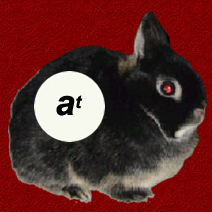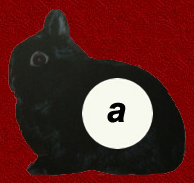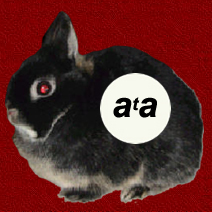The Basic Patterns (The A Series)
Even
though
the
Netherland Dwarf breed standard
separates
the recognized varieties into five colour groups
(Self, Shaded, Agouti, Tan Pattern and Any Other Variety), there are actually
only three colour patterns. The
five colour groups exist in
the
breed standard because we classify a variety by
its appearance (phenotype),
rather than by its genetic make-up (genotype).
From the standpoint of colour genetics the varieties fit into
just three colour patterns: agouti pattern, tan pattern, and self pattern.
The concept of 'pattern' here refers to the arrangement
of colour on the individual hair shafts and to the placement of coloured areas
on the rabbit.
The
"ladder of
dominance"
below illustrates how the three pattern genes are ranked, according to their
dominance or recessiveness to one another
from top to bottom of the "ladder":
A
= agouti pattern
at
= tan pattern
a
= self pattern
This
is an important concept regarding
degrees of dominance, as evidenced by the tan pattern at,
which is sometimes recessive (when in the company of agouti pattern A)
and sometimes dominant (when in the presence of self pattern a).
Inheritance of the pattern
genes follows simple genetic laws. Each
rabbit
inherits
one pattern
gene from its sire and
one pattern
gene from its dam -
a total of
two pattern genes. The
rabbit
might inherit two of the
same pattern
genes. For example, two agouti pattern genes (AA), or
two self pattern genes (aa).
Or it
might inherit two
different pattern genes;
eg one
agouti gene and one tan gene (Aat), or one tan gene and one self gene (ata).
A rabbit
who
inherits even one agouti pattern A
gene will be an
agouti-patterned variety, because A is fully dominant over the other pattern genes.
Therefore,
we are sure that any agouti-patterned Netherland Dwarf is
carrying at least one agouti pattern A.
However, we
can't
tell by
merely looking at the rabbit which other colour pattern gene was inherited.
The rabbit may be carrying a second agouti A
gene (making it AA) or a tan pattern at gene (making
it Aat) or a self pattern a gene (thus making it Aa).
Incidentally, inheriting two agouti pattern A
genes (genotype AA) does not make the Dwarf anymore of an agouti than does
inheriting a single agouti pattern A
gene in conjunction with one of the other pattern genes.
There are no degrees of agouti-ness (or of tan-ness
etc).
It's an all-or-nothing action. If
the
rabbit
inherits an agouti pattern A
gene, it will be an agouti-patterned variety: if
it
doesn't inherit an
agouti pattern A gene, it will be
other than agouti patterned.
The
example below illustrates how the pattern genes operate.
The
rabbit will
inherit a tan pattern at
from its sire and a self pattern a
gene from its dam.
 x
x 
Sire
(tan patterned) Dam (self patterned)

offspring (tan patterned)
As
we know at
is dominant over a, we know that the tan pattern at
will prevail and that the
rabbit will be some variety of tan pattern.
The
rabbit's genotype is ata
(the dominant gene is always written first, the recessive gene
second).
We can tell by looking (by observing its phenotype)
that the
tan-patterned rabbit
is carrying at least one at gene, but we can't tell by looking that
it's genotype
includes the self pattern a.
Either a second tan pattern at
gene or a self pattern a gene has been
inherited. Since we have the parents available for observation
we can see
had to inherit its
mother's self pattern a
gene. This recessive self
pattern a gene is being masked by the
dominant tan pattern at gene inherited
from the sire. Self-patterned
Netherland Dwarfs are always genotype aa
because any other combination of pattern genes (Aa
or ata) would dominate over the
more recessive self pattern, resulting in either an agouti patterned or a tan patterned rabbit.
The genetic self-patterned
varieties include the Black, Blue, Chocolate
and Lilac of the Self Group, plus the
Seal Point, Siamese Sable and Siamese Smoke of the Shaded Group.
These 'shaded selfs' are self-patterned varieties in which other colour
genes have lightened
the colour in the middle
section of the fur shaft.
Additionally, the Tortoiseshell is a
genetically
self-patterned variety in which yet
another gene action has weakened the colour of the saddle from black to orange,
while leaving the extremities essentially black.
Phenotypically (appearance-wise) it should be included
in the Shaded Group.
colour distribution in the fur shaft
non - extension in the fur shaft